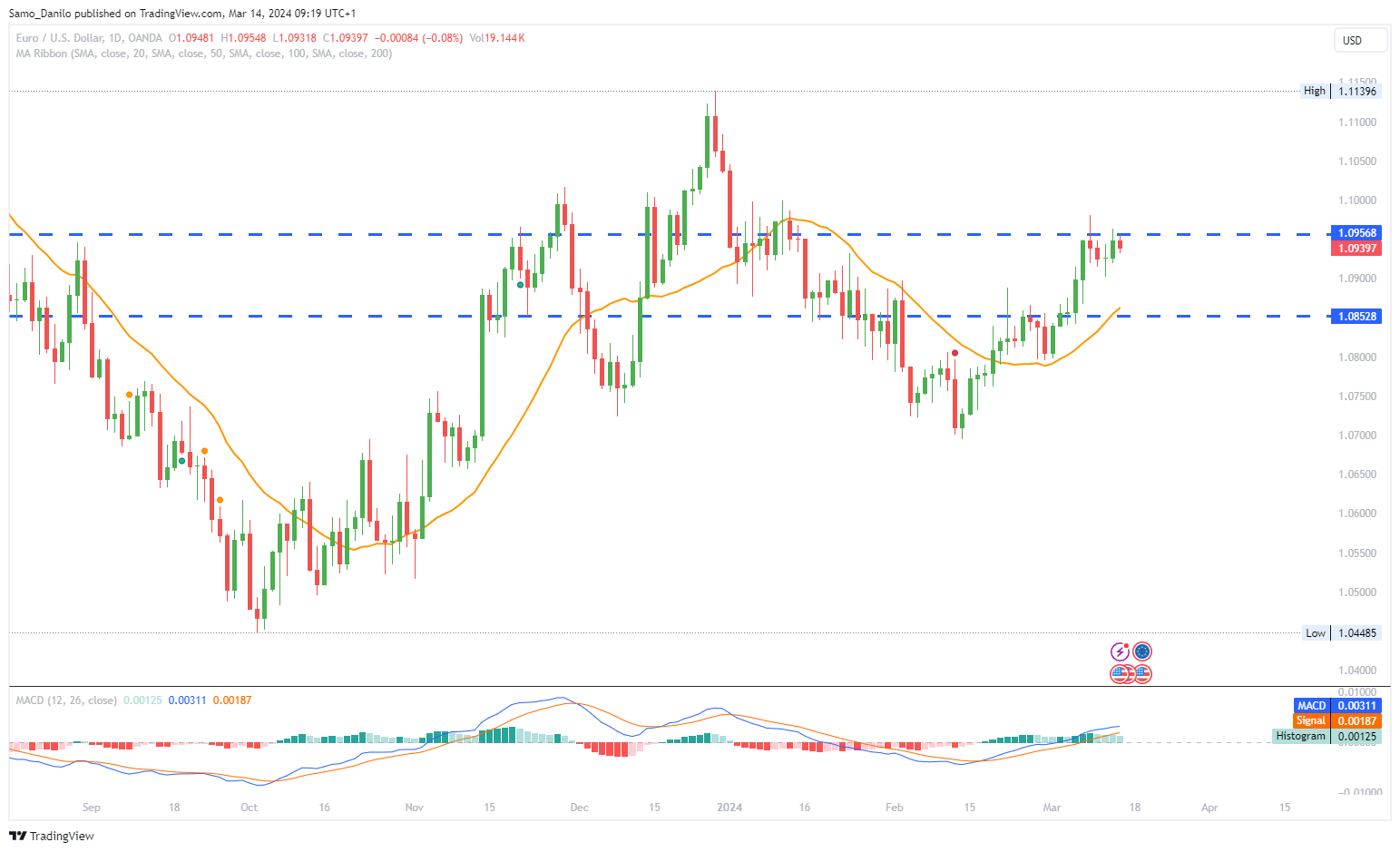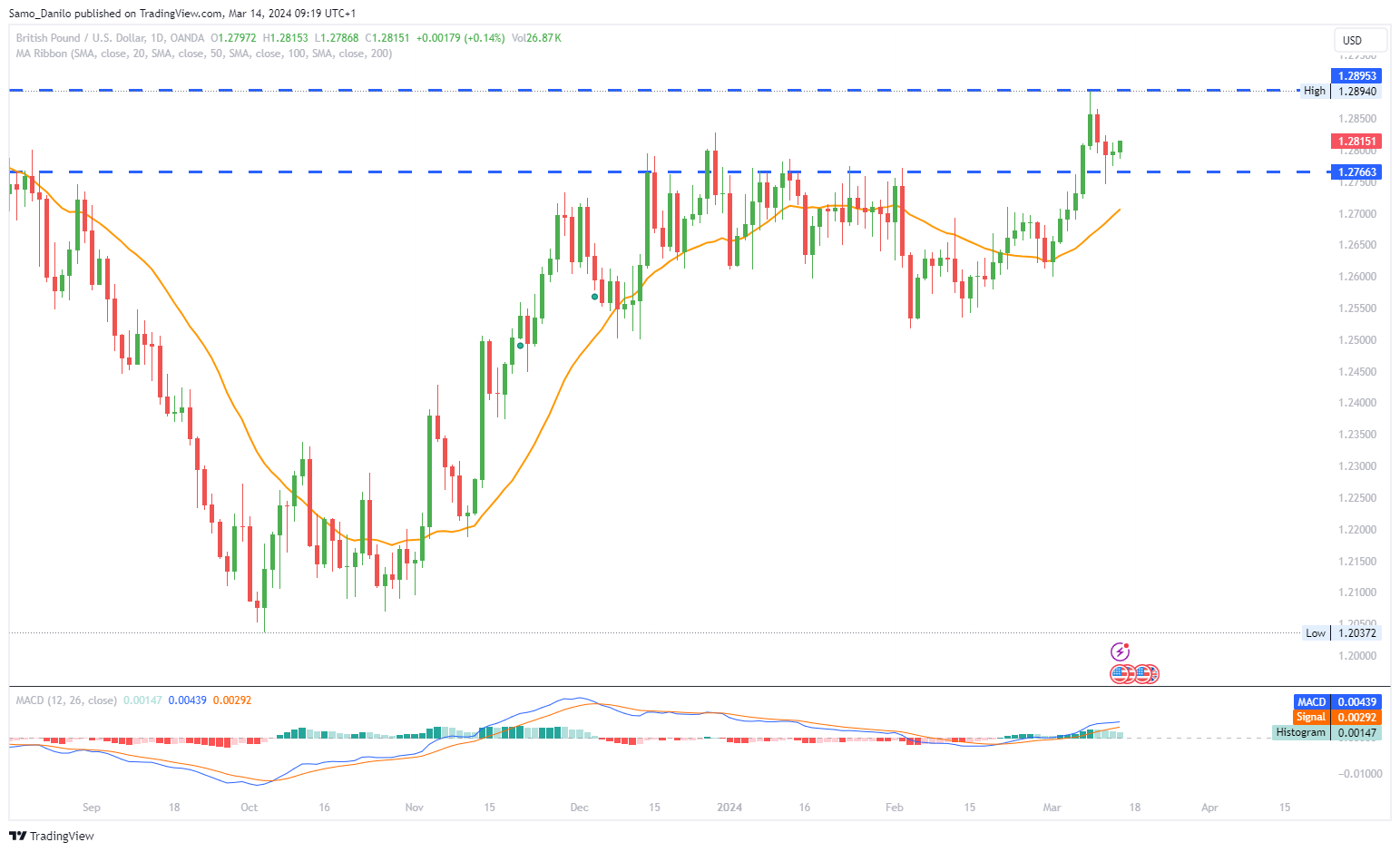EURUSD
- Current Trading Position: The EUR/USD pair is experiencing weakness, trading below the mid-1.0900s during the early European session on Thursday. This suggests a prevailing sentiment favoring the US Dollar against the Euro.
- US February Retail Sales Data Release: Market participants are awaiting the release of US February Retail Sales data, expected to show a month-on-month increase of 0.8%. This economic indicator could potentially impact the pair's movement, depending on whether the actual figures meet, exceed, or fall short of expectations.
- ECB Commentary Influence: Recent commentary from European Central Bank (ECB) officials has influenced market sentiment. Board member Villeroy suggested the possibility of a rate cut in spring, emphasizing the Governing Council's commitment to maintaining vigilance until the 2% inflation target is achieved. This dovish stance from Villeroy suggests a potential easing bias from the ECB.
- Cautionary Note from Kazaks: Another ECB official, Kazaks, warned of significant uncertainty and indicated that decisions on rates will be made in upcoming meetings. He highlighted the importance of avoiding excessive delay in rate reductions. Such cautionary remarks underscore the challenges and complexities facing ECB policymakers in managing monetary policy amidst economic uncertainties.
- Medium-Term Outlook: The relatively sluggish economic fundamentals in the euro area, juxtaposed with the resilience of the US economy, reinforce the expectation of a stronger US Dollar in the medium term. This outlook suggests a continuation of the current trend favoring the US Dollar over the Euro in the currency pair.
Closing statement: The EUR/USD pair faces a mix of factors influencing its current trading position. Market participants are closely monitoring US Retail Sales data and digesting recent ECB commentary, which hints at a potential rate cut. The medium-term outlook leans toward a stronger US Dollar against the Euro, reflecting the contrasting economic fundamentals between the euro area and the US.
GBPUSD
- Current Trading Position: GBP/USD continues to face challenges near the 1.2800 mark in the early European session on Thursday. This indicates a persistent struggle for the currency pair around this key psychological level.
- UK Economic Indicators: Recent UK economic data releases provide insights into the country's economic performance. According to the Office for National Statistics (ONS), the UK monthly GDP estimate for January showed a 0.2% month-on-month increase, rebounding from a 0.1% contraction in the previous reading. However, Industrial Production declined by 0.2% in January compared to December's 0.6% month-on-month gain. These mixed indicators reflect the ongoing challenges and uncertainties facing the UK economy.
- US Retail Sales Data: Traders are closely monitoring the release of US Retail Sales data for February, which could influence the Federal Reserve's (Fed) monetary policy decisions. The expected rise of 0.8% month-on-month in February, following a 0.8% fall in January, suggests potential improvements in consumer spending trends. Positive retail sales figures may impact market expectations regarding the Fed's future actions.
- UK Consumer Inflation Expectations and FOMC Interest Rate Decision: Market participants await the release of UK Consumer Inflation Expectations on Friday, which could provide insights into consumer sentiment and inflation expectations in the UK. Additionally, investors will shift their focus to the upcoming Federal Open Market Committee (FOMC) interest rate decision next week, which could influence the direction of GBP/USD depending on the Fed's policy outlook and guidance.
| SMA (20) | Rising |
|
|
| RSI (14) | Slightly Falling |
| |
| MACD (12, 26, 9) | Rising |
|
|
Closing statement: GBP/USD faces a challenging environment as it struggles near the 1.2800 mark. Recent UK economic data releases show mixed performance, while market attention turns to US Retail Sales data and upcoming events such as UK Consumer Inflation Expectations and the FOMC interest rate decision. The currency pair remains sensitive to developments in both the UK and US economies, along with shifts in market sentiment and central bank policies.
GOLD
- Current Gold Price Movement: Gold is currently trading around $2,170, showing a relatively stable pattern as it awaits further market catalysts for the next significant movement.
- US Dollar Dynamics: The US Dollar experienced a reversal on Wednesday, undoing most of the gains driven by the hot US Consumer Price Index (CPI) data. Despite the strong inflation figures, market expectations for a June Federal Reserve (Fed) interest rate cut remained relatively unchanged, hovering around 70%. This dynamic suggests that investors are interpreting the inflation data in the context of the Fed's monetary policy stance.
- Upcoming US Economic Data: Traders are eagerly awaiting the release of high-impact US economic data, including Retail Sales and Producer Price Index (PPI) figures. These data points are expected to provide fresh insights into the timing of potential Fed rate cuts, which could significantly influence gold prices. Additionally, the weekly US Initial Jobless Claims data will be closely monitored for any signals affecting Gold's trading sentiment.
- Market Sentiment and Gold Price Outlook: The potential implications of sticky inflation and strong consumer demand in the US may pose challenges for gold prices. As investors assess the economic data releases and Fed policy expectations, Gold may experience fluctuations based on shifts in market sentiment and risk perceptions.
| SMA (20) | Rising |
|
|
| RSI (14) | Slightly Rising |
| |
| MACD (12, 26, 9) | Rising |
|
|
Closing statement: Gold remains relatively stable around $2,170 as it awaits key US economic data releases for further direction. The US Dollar's reversal following strong inflation data and market expectations for a Fed rate cut in June are influencing Gold's short-term trajectory. Traders are closely monitoring upcoming economic indicators for fresh insights into the Fed's policy outlook and its potential impact on gold prices.
CRUDE OIL
- Current WTI Oil Price Movement: West Texas Intermediate (WTI) oil prices are experiencing a consecutive upward trend, reaching around $80 per barrel. This marks the second consecutive session of price increases, indicating positive momentum in the oil market.
- Surprise Decrease in US Crude Stockpiles: The recent surge in oil prices is primarily attributed to a surprise decrease in US Crude stockpiles. This unexpected decline suggests a strengthening demand for crude oil, which is contributing to the upward pressure on prices.
- Geopolitical Tensions: Concerns over potential supply disruptions have also contributed to the bullish sentiment in the oil market. Recent Ukrainian attacks on Russian refineries have raised concerns about supply disruptions, further bolstering oil prices.
- IEA and OPEC Dynamics: The International Energy Agency (IEA) has advised industrialized nations on various energy-related matters. Tensions between the IEA and the Organization of the Petroleum Exporting Countries (OPEC) have been noted, particularly regarding long-term demand forecasts and the need for investment in new oil supplies.
- OPEC Response: Despite the tensions, OPEC has expressed appreciation for the remarks made by the IEA. Both organizations emphasize the importance of oil security and the need for collaboration to address challenges and ensure stability in the global oil market.
| SMA (20) | Rising |
|
|
| RSI (14) | Slightly Rising |
| |
| MACD (12, 26, 9) | Slightly Rising |
|
Closing statement: WTI oil prices are on an upward trajectory, supported by a surprise decrease in US Crude stockpiles and concerns over potential supply disruptions due to geopolitical tensions. The dynamics between the IEA and OPEC highlight ongoing discussions about long-term demand and the importance of collaboration in ensuring oil security. As market participants continue to monitor supply-demand dynamics and geopolitical developments, oil prices may experience further fluctuations in the near term.
DAX
- Eurozone Industrial Production Data Impact: Industrial production numbers for the Eurozone released on Wednesday have influenced market sentiment regarding the European Central Bank (ECB) policy outlook. The data revealed a significant decline, with industrial production sliding by 3.2% in January after a 1.6% rise in December. This downturn has fueled speculation of an ECB rate cut in the first half of 2024.
- Macroeconomic Environment Concerns: The January industrial production figures underscored concerns about the deteriorating macroeconomic environment in the euro area. This has further fueled expectations of an ECB rate cut in the first half of 2024, as market participants adjust their outlook based on the latest economic data.
- Importance of ECB Commentary: Investors are closely monitoring ECB commentary on Thursday, as any indications of support for a June ECB rate cut could impact demand for DAX-listed stocks. ECB Executive Board members Frank Elderson, Isabel Schnabel, and Luis de Guindos are scheduled to speak, and their remarks could provide insights into the central bank's policy stance.
- Earnings Calendar Impact: The earnings calendar also holds significance for DAX price trends. Companies such as Rheinmetall AG, RTL Group, and RWE AG are among the major names scheduled to release earnings reports. The market's reaction to these earnings releases could influence sentiment surrounding DAX-listed stocks.
- US Economic Calendar Influence: Additionally, market risk sentiment early in the US session may be influenced by the US economic calendar. Producer prices and retail sales figures for February are expected to be released, and these data points could shape expectations regarding a potential Fed rate cut in the first half of 2024.
| SMA (20) | Rising |
|
|
| RSI (14) | Rising |
|
|
| MACD (12, 26, 9) | Rising |
|
|
Closing statement: The DAX is navigating through various factors, including Eurozone industrial production data, ECB commentary, earnings reports, and US economic indicators. Market sentiment is being shaped by expectations of ECB policy adjustments in response to economic conditions, as well as corporate earnings performance and developments in the US economy. As investors digest incoming data and commentary, the DAX may experience fluctuations in the near term.




